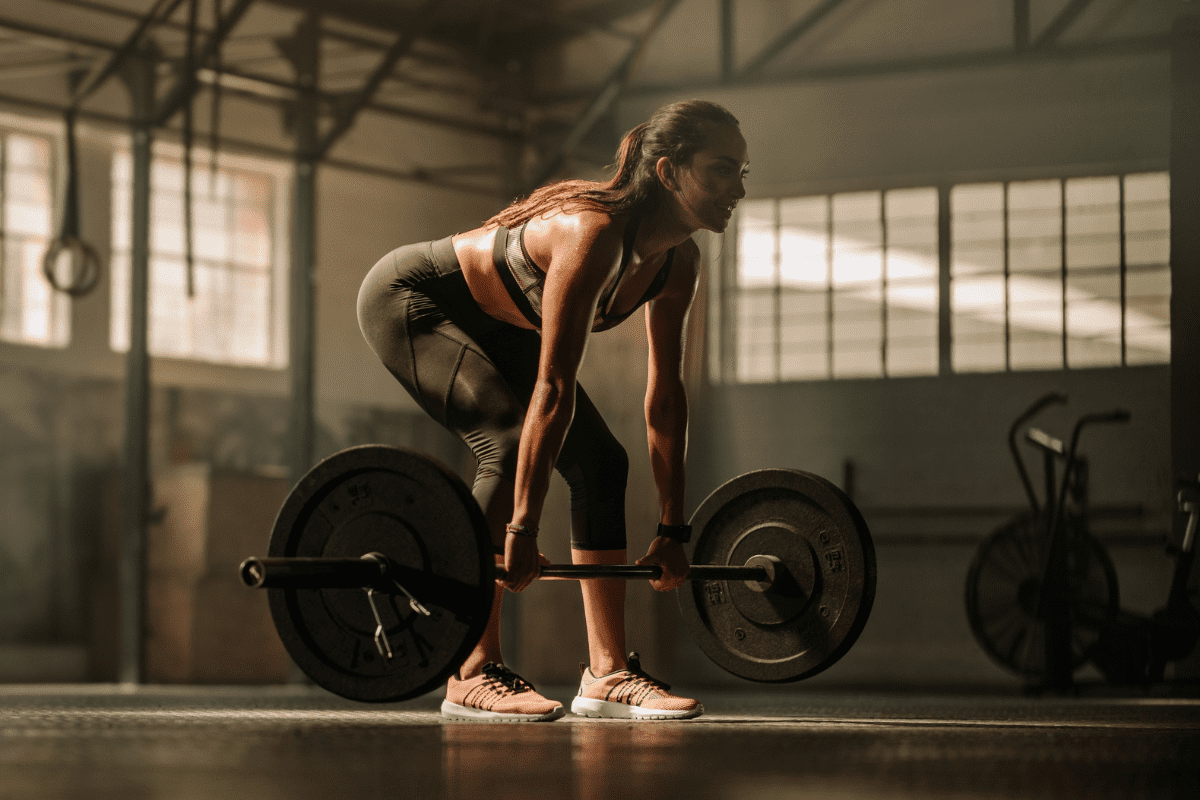12 Reverse Hyperextension Alternatives For Posterior Chain
Reverse Hyperextensions, or Reverse Hypers for short, is an excellent exercise for training the glutes and building posterior chain strength. The Reverse Hyperextension Machine is big and not exactly cheap, but if you have access to one they’re great to incorporate into your strength program.
However, you may have situations where you need an alternative to Reverse Hypers.
The most obvious is if you’re working out of your garage as I do, there is a good chance you don’t have a Reverse Hyperextension Machine. However, you may also be looking to add some variety to your workout plan.
Whatever the reason, you’re in the right place. I’ve been a College Strength Coach for two decades and I’m about to share with you 12 of my favorite alternative exercises for Reverse Hypers.
Reverse Hyperextension Alternatives
I’ve tried to make this list of alternatives as diverse as possible. There are exercises that use a barbell, dumbbells and even no equipment at all.
Hopefully, no matter what equipment you have or what your lifting experience is – one of these alternatives can serve as a replacement for Reverse Hypers.
Romanian Deadlift (RDL)
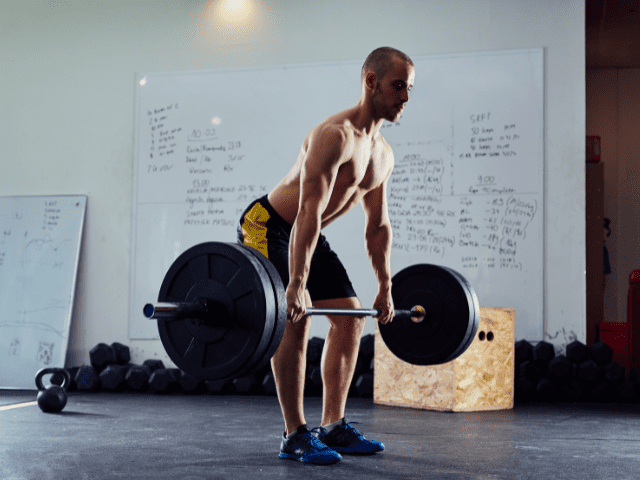
I’m starting this list of Reverse Hyperextension alternatives with RDLs, or Romanian Deadlifts. RDLs are one of the most highly effective exercises for training the posterior chain and they are an absolute staple in my programming.
How To
- Begin by standing upright, holding a barbell in front of you with an overhand grip.
- Feet should be hip-width apart with a slight bend in the knees.
- Keeping a neutral spine and your chest up, hinge at the hips, pushing them backward.
- Allow the barbell to slide down close to your legs. Your back remains straight throughout.
- Lower the bar until you feel a strong stretch in your hamstrings or it reaches mid-shin level, whichever comes first.
- Engage your hamstrings and glutes, then reverse the motion, bringing the barbell back to the starting position.
Coaching Points
The ‘depth’ that each person gets doing Romanian Deadlifts will be different and absolutely solely dependent upon hamstring flexibility.
Do NOT try to ‘reach’ the barbell toward the ground because you believe the plates should touch the floor. If you have tight hamstrings you may be doing well to get the bar to mid-shin.
Trying to reach the bar to the floor will result in the lifter losing their neutral spine and rounding their back.
Dumbbell RDL
The Dumbbell RDL is another variation of Romanian Deadlifts. Depending on what equipment you have available to you, either can make an excellent Reverse Hyperextension alternative.
Step-by-Step Instruction
- Stand with your feet hip-width apart, maintaining a slight bend in the knees.
- Begin by hinging at your hips, pushing them backward, and lowering the dumbbells along your shins.
- Keep your back straight and chest up, ensuring the dumbbells stay close to your legs throughout the descent.
- Once you feel a stretch in your hamstrings or the dumbbells reach mid-shin level, reverse the motion.
- Engage your hamstrings and glutes to pull yourself back to the starting position.
Coaching Points
During Dumbbell RDLs, it is important for the lifter to maintain a neutral spine, maintaining tension in the abdomen and upper back. Remember to breathe in and hold the breath during eccentric (lowering the weight) and breathe out as you perform the concentric movement (bringing the weight back up).
Single Leg Dumbbell RDL
The third (and final) RDL variation is the Single-Leg RDL. This variation incorporates balance and coordination in addition to being a great exercise to target the hamstrings isolaterally.
Step-by-Step Instruction
- Stand on one leg, holding the weight in the opposite hand.
- Keeping a slight bend in the standing leg, hinge forward at the hip while extending the free leg straight behind you.
- Lower the weight towards the ground while maintaining a straight line from head to extended foot.
- Pause briefly at the bottom without rounding your back.
- Engage your hamstring and glute to return to the starting position, maintaining balance.
Coaching Points
Do not let the weight drift over the midline when doing Single Leg RDLs. You will train for more structural stability if you keep the dumbbell in front of the down leg.
Maintain the arch of the foot. When performing single-leg movements, it is very important to maintain balance to yield all the benefits of single-leg exercises.
It is important for the lifter to maintain a neutral spine, maintaining tension in the abdomen and upper back.
Kettlebell Swing

A more dynamic posterior chain exercise is the Kettlebell Swing. If you’re looking for an explosive type of exercise to replace your Reverse Hyperextensions, then Swings are a great option.
Step-by-Step Instruction
- Stand with feet shoulder-width apart, holding the kettlebell with both hands in front of you.
- Push your hips back, bending slightly at the knees, and lowering the kettlebell between your legs.
- Powerfully extend your hips and knees, swinging the kettlebell forward and upward to chest height.
- At the peak, your body should be in a straight line from head to heels.
- Allow the kettlebell to swing back down, hinging at the hips, and preparing for the next repetition.
Coaching Points
The Kettlebell Swing is a great movement to train rapid hip extension and flexion. Remember to always keep a neutral spine (DO NOT ROUND YOUR BACK).
Choosing the proper kettlebell weight is important. Heavier is not always better. Because of the rapid nature of the kettlebell swing, the emphasis should be on velocity, speed, and power.
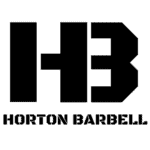
Tired of coming up with your own workouts? But don’t want to pay an arm and a leg?
I post workouts 5 days a week right here. (Did I mention they’re free?)
Hyperextensions
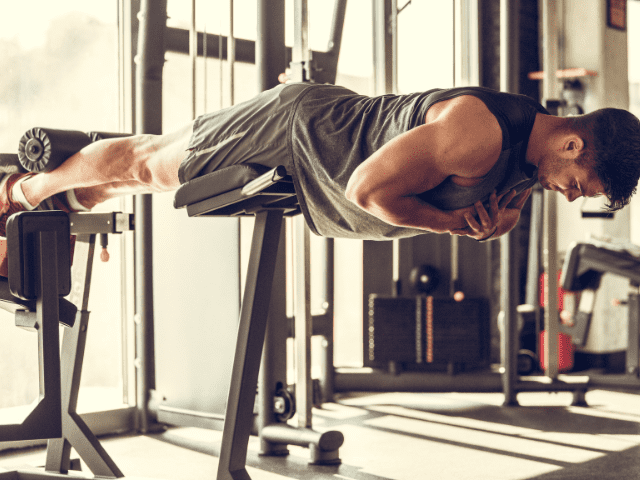
This one may be obvious to many, but Hyperextensions can serve as a great Reverse Hyperextension alternative.
Step-by-Step Instruction
- Position yourself on the hyperextension bench with your thighs against the pad and feet securely under the footplate.
- Cross your arms over your chest or place hands behind your head. Ensure your spine is neutral.
- Begin the exercise by bending at the hips, lowering your upper body toward the floor.
- Lower yourself as far as comfortable while maintaining a straight back.
- Lift your torso by extending your hips until your body forms a straight line from head to heels.
- Squeeze your glutes at the top of the movement, ensuring your back remains straight, not hyperextended.
- Slowly lower back to the starting position and prepare for the next repetition.
Coaching Points
It is important for the lifter to maintain a neutral spine when doing Hyperextensions, maintaining tension in the abdomen and upper back. Remember to breathe in and hold the breath during eccentric (lowering your body) and breathe out as you perform the concentric movement (bringing your body back up).
Glute Ham Raise
Glute Ham Raises take the Hyperexension and combine it essentially with a Nordic Hamstring Curl. One of the most challenging Reverse Hyperexension alternatives on this list.
Step-by-Step Instruction
- Position yourself on a Glute Ham Developer (GHD) machine with your feet secured under the roller and your knees just behind the pad.
- Start with your body in a straight line from your knees to your head, torso upright.
- Begin the movement by slowly lowering your torso forward and downward, maintaining a straight line from your knees through your head.
- When you’ve descended as far as possible with control, use your hamstrings and glutes to reverse the motion.
- Pull yourself back up to the starting position, squeezing your glutes at the top of the movement.
Coaching Points
One of the common mistakes I’ve seen with Glute Ham Raises is athletes will pull with the hamstrings and not engage the glutes.
What this looks like is the athlete leaves their hips behind and they don’t quite get to perpendicular because they didn’t extend the hips and engage the glutes.
Glute Bridge
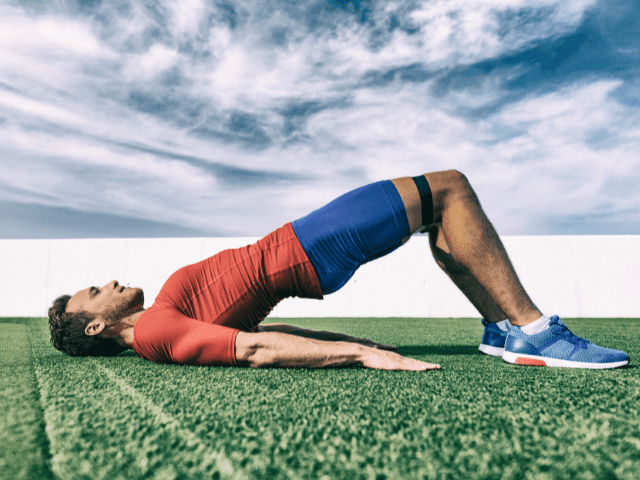
Glute Bridges aren’t going to develop strength the way many of the other Reverse Hyperextension alternate options are, but they can fit great into a warm-up for glute activation.
Step-by-Step Instructions
- Start by laying on your back on the ground.
- Bend both knees to about a 90-degree angle and place both feet flat on the floor.
- Begin the rep by driving your hips up into the air. Try to attain a straight line from the shoulders through the hips and knees.
- Squeeze the glutes at the top of the rep and then lower back down to the starting position.
Coaching Points
As you raise the hips up, try to drive the knees slightly forward. This can help with getting a strong glute contraction and a full extension of the hips. Don’t rush through Glute Bridges. Make sure to pause and squeeze at the top of each rep.
Single Leg Glute Bridge
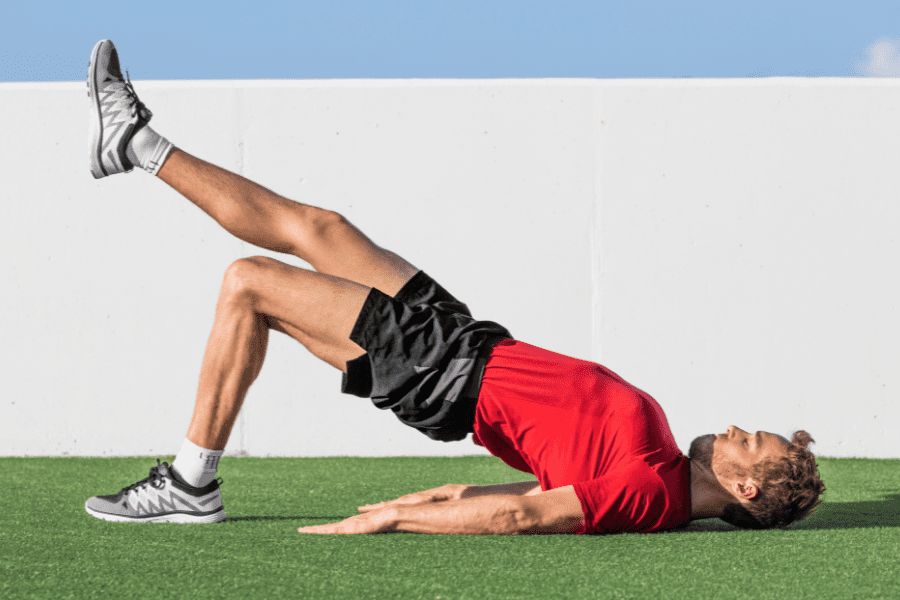
It can be almost shocking how much more challenging a Single Leg Glute Bridge can be compared to its double-legged cousin. If you haven’t already, definitely give these a try.
Step-by-Step Instructions
- Start by laying on your back on the ground.
- Bend both knees to about a 90-degree angle and place both feet flat on the floor.
- Now, extend one leg straight out, still keeping both knees side by side.
- Begin the rep by driving your hips up into the air. Try to attain a straight line from the ankle through the knees and hips.
- Squeeze the glute at the top of the rep and then lower back down to the starting position.
Coaching Points
As you raise the hips up, try to drive the knee slightly forward (the leg with the foot on the ground). This can help with getting a strong glute contraction and a full extension of the hips.
Keep both knees side by side during the whole movement. Some athletes will tend to lift the straight leg higher in the air or let it trail lower.
Banded Good Mornings
I’m not the biggest fan of Barbell Good Mornings, but I love Banded Good Mornings to get in some supplemental posterior chain volume (or as part of a warm-up).
Step-by-Step Instructions
- Stand on a resistance band and pull it up over the head and across the back of the shoulders.
- Stand tall with feet hip-width apart, hands holding and securing the band in place.
- Put a slight bend in the knee and pull the shoulder blades back.
- Now, hinge at the hips by pushing the hips back and bending at the waist. Push your knees out slightly as you descend.
- Keep the back slightly arched throughout the movement.
- Continue the hinge until you feel a stretch in the hamstrings.
- Stand back up tall and push the hips forward to the starting position.
Coaching Points
Banded Good Mornings can serve as a warm-up movement or as a strength-building exercise, usually as part of a circuit.
Listen to your body. Depending on your hamstring (and sometimes glute or low back) flexibility, you may be able to lower down quite far or not very much at all. The key is to move just to the edge of your range of motion. Don’t try to force anything.
Stability Ball Leg Curl
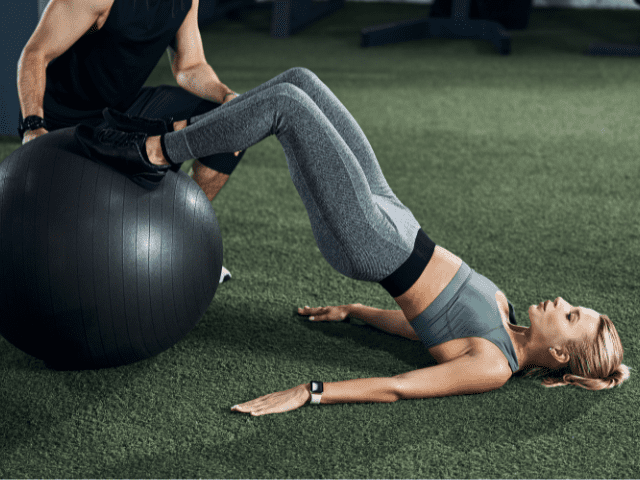
Out of the more beginner-friendly Reverse Hyperextension alternatives, Stability Ball Leg Curls can still provide a good challenge to the hamstrings and glutes.
Step-by-Step Instruction
- Lie down on your back and almost fully extend your legs.
- Place your heels on the ball.
- Drive your elbows into the floor and keep your abdomen tight. Drive your heels into the ball.
- Drive your hips to the ceiling and engage your glutes.
- Keeping your core nice and tight, pull the ball under your butt as much as possible.
- At the top of this movement, keep the glutes engaged and core tight.
- Engaging the hamstrings, roll the ball back until your body is almost fully straight.
Coaching Points
Make sure the stability ball is properly inflated when doing Stability Ball Leg Curls. If it is not, the muscles we are training will not engage fully.
Remember to always squeeze with the glutes and actively engage the hamstrings. Do not round the back and push your belly to the sky. Keep the anterior core locked in throughout the movement.
Floor Slider Leg Curl
Step-by-Step Instruction
- Lie down on your back and bend your knees at about 90 degrees.
- Place the sliders under the heels of your feet.
- Drive your elbows into the floor and keep your abdomen tight.
- Drive your hips to the ceiling and engage your glutes.
- Keeping your core nice and tight, slowly slide your heels away from your body until your knees are almost fully extended.
- At the end range of this movement, your body should be straight, hips up, and core engaged.
- Engaging the hamstrings, pull your heels back to the starting position and squeeze the glutes to resume the starting position.
Coaching Points
One of the most important points about this movement is the surface you are sliding on and the type of slider you’re using.
The furniture slide should freely move with little resistance, I would say carpet is ideal if available. If there is resistance, this may affect your technique and coordination.
Remember to always squeeze with the glutes and actively engage the hamstrings. Do not round the back and push your belly to the sky. Keep the anterior core locked in throughout Floor Slider Leg Curls.
Supermans
Step-by-Step Instructions
- Lay on your stomach with legs straight and arms stretched out overhead.
- Contract the low back and glutes and raise the chest, arms and legs (thighs) off the ground.
- Squeeze and hold for a one count and then lower back down to the ground.
Coaching Points
Take your time and don’t rush through the movement. Squeeze the top of each rep and lower yourself back to the ground under control. Too often I see athletes just quickly go through the motions with Supermans – focus on each rep to get the max benefit.

Get Shredded… For Free
Get a free workout Monday through Friday, posted right here on Horton Barbell. These workouts are designed to help you get strong, in shape and look great at the beach!
Final Thoughts
Reverse Hyperextensions are an amazing exercise for engaging and developing the glutes. However, if you don’t have a Reverse Hyperextension Machine then you’re going to need an alternative for them.
Hopefully, this list has helped you figure out a different movement that you can use as a substitute.

